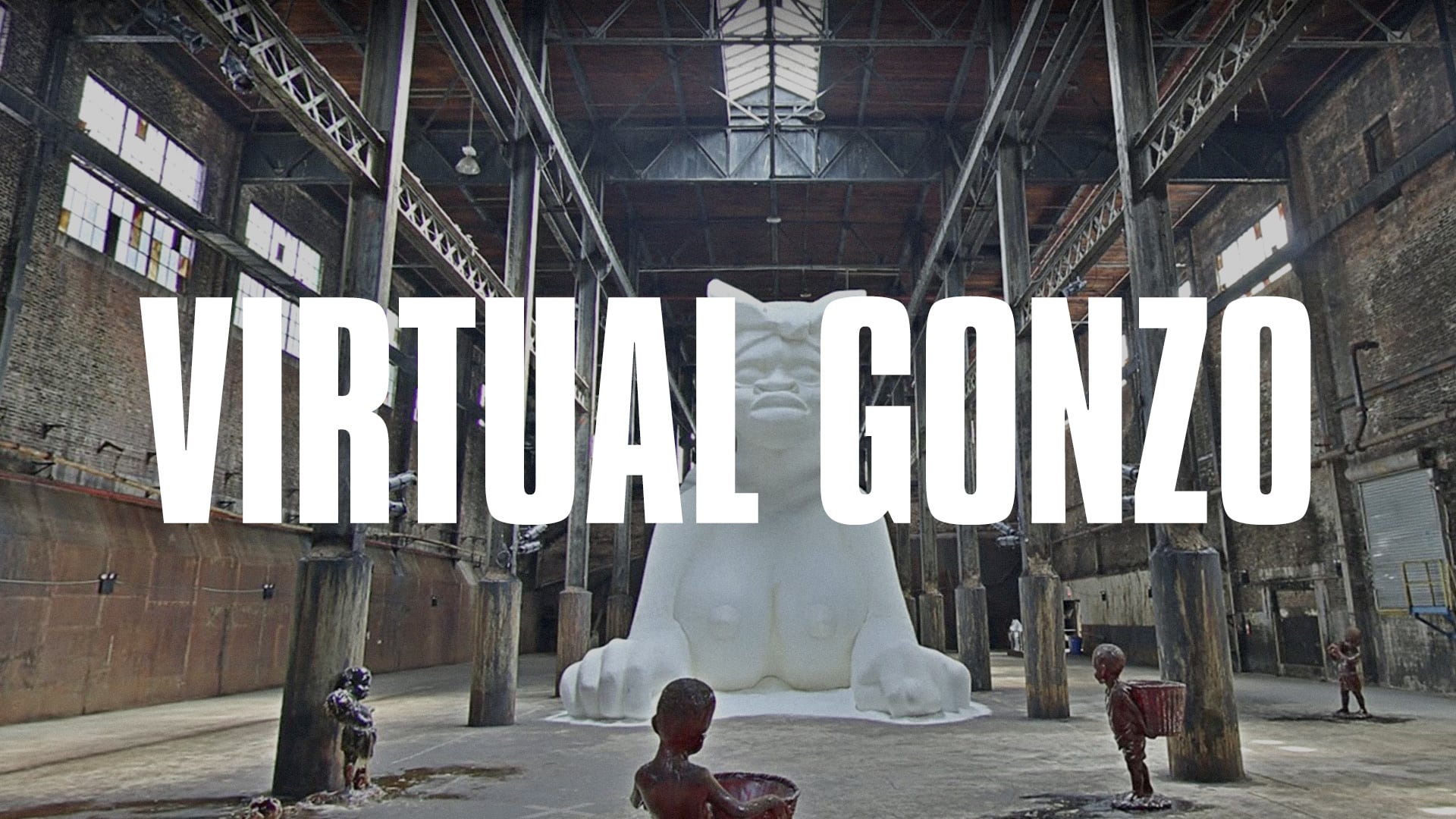

First, we drifted on Christo and Jeanne-Claude’s ‘Floating Piers’ in Italy. Next, we traded lockdown for lock up, with Ai Weiwei on Alcatraz. Last time we walked The Line, London’s first dedicated public art walk. This time, we’re exploring a sprawling industrial relic in Williamsburg, Brooklyn. In 2014, the Domino Sugar Refinery housed a monumental statue by Kara Walker: a riddle wrapped up in the history of power.
I’m inside the abandoned Domino Sugar Factory in Williamsburg, Brooklyn, wishing Street View had an olfactory function. Syrupy residue runs down the walls, streaks of molasses baked in as a barcode. Puddles of decade-old sugar-water soak the floor. I bet the whole place would smell dirty-great. Acrid burnt sugar. The same wrong-but-right of petrol. Your shoes would stick to the floor, like in a decent club.
I bet the whole place would smell dirty-great. Acrid burnt sugar. The same wrong-but-right of petrol
A procession of rusty steel columns holds up this cavernous space, and sitting sandwiched between them is a mighty sphinx some forty-feet tall. Regal, terrifying, she’s sculpted from bleached sugar, which catches the light spilling through windows high overhead.
Derived from racist mammy imagery, she has a kerchief tied round her head and large lips set in a severe grimace. Cartoonish, pendulous breasts touch the ground between two outstretched arms — which read as a big cat’s legs, only with boulder-sized hands for paws. With her left, she makes the ‘fig sign’, signifying either good fortune or f**k you. For now, confronted with this complicated mixture of mythic caregiver, sex object, and appropriated racism, I’m leaning towards the latter.

This is Kara Walker’s ‘A Subtlety’ (2014). Named after the medieval penchant for elaborately sculpted sugar treats to mark the beginning or end of a course, it comes with a real mouthful of a subtitle:
A Subtlety
or the Marvelous Sugar Baby
an Homage to the unpaid and overworked Artisans who have refined our Sweet tastes from the cane fields to the Kitchens of the New World on the Occasion of the demolition of the Domino Sugar Refining Plant
Steering through race, class, greed and consumption, you find the full force of history careening towards you like a bus
It’s a title that puts a busy intersection in intersectionality: steering through race, class, greed and consumption, you find the full force of history careening towards you like a bus. You turn to frantic googling.
Here are some clips: Consider that outside the Refinery, on the East River, in the 1700s, great ships would drop off tons of sugarcane from the Caribbean, docking alongside ships carrying slaves who would be forced to turn it into sugar. Consider, centuries later, those indentured workers who held a 20-month strike at Domino Sugar, the longest in New York history. Hear Karl Marx, who would say there is ‘congealed labour-time’ in sugar. Try to push that out of your mind the next time you put a spoonful in your tea.
ArrayConsider Robert Shelton, who worked in Domino’s kiln department in up to 60°C heat until 2004. ‘Most people who worked in that building have some form of cancer,’ he told The Atlantic. ‘You’re dealing with acid, lime, particle dust that is so fine.’ Consider these kilns, two to three stories tall, used to produce bone char for the filtering process. Consider bodies of all kinds.
Consider the word ‘refined’, which we associate with high society. Consider that once upon a time sugar was a delicacy for wealthy elites. Then, consider contemporary America, where every 17 seconds someone is diagnosed with diabetes. Consider that African American adults are 60% more likely to be diagnosed with diabetes than non-Hispanic white adults. Consider that the Havermayer family, who owned the Refinery, made their fortune turning brown sugar to white. Consider whiteness. Blackness.
Look up at the mammy sphinx’s blank eyes. Those of a blind diviner. You may well need some air
Consider that sphinxes are said to possess an unsolvable riddle. Consider the Great Sphinx of Giza built on the backs of slaves. Then come back to the children sculpted from molasses in what was once the Raw Sugar Warehouse, black boys with big sweet eyes carrying baskets, serving their overlord. Look up at the mammy sphinx’s blank eyes. Those of a blind diviner. You may well need some air.
Step outside and into Street View from 2018, and find that Walker’s monumental guardian was unable to save the Domino Sugar Refinery from becoming extinct like all the other industrial dinosaurs. The building is now surrounded by cladding reading ‘DOMINO PARK’. It has been condo-ed out like the rest of Williamsburg’s waterfront.

Click along an elevated walkway cantilevered off of 21 columns from the old warehouse. Below are the original mooring bollards used to secure docking ships; above are the huge gantry cranes used to lift sugar out of them — relics now painted a palatable teal. Children are playing in the park, on aluminium slides made from salvaged valve wheels. There’s a long queue for Tacocina.
Is this the future that the sphinx foresaw? Bittersweet. To say the least
It would be nice to sit for a minute on one of those benches overlooking the East River. To turn your gaze south to the Williamsburg Bridge in sun, fog, falling light or glittering against a darkening sky. Is this the future that the sphinx foresaw? Bittersweet. To say the least. Past an urban beach volleyball court and four towering syrup tanks, you leave with a discomfiting taste in your mouth.




